Prepared for Environment Council, 4 March 2002
![Bullet [round green/blue] Bullet [round green/blue]](https://eea.europa.eu./media/speeches/eea-all-bullet-eea-icon.gif) Download the working paper [Pdf 177 Kb]
Download the working paper [Pdf 177 Kb]
Working Paper
Introduction
In May 2002 the European Environment Agency will publish this year's edition of its annual indicator-based assessment of major environmental trends, Environmental signals 2002.
In view of the planned discussion by the 4 March Environment Council on input to the Barcelona summit, which will review progress in the EU Sustainable Development Strategy (SDS), the Agency believes it may be helpful for ministers to receive the most up-to-date information on the environmental dimension of the SDS. This paper aims to provide this information by drawing on the current draft of Environmental signals 2002 as well as other reports and sources.
The European Commission's Communication to the Barcelona summit, The Lisbon Strategy -- making change happen, is an important milestone on the way to ensuring sustainable development in Europe. The review of progress towards sustainable development that will take place in Barcelona is the first since the SDS was agreed at the European Council in Gothenburg last year. The conclusions due to be adopted by the 4 March Environment Council should help to focus the attention of Europe's leaders on the SDS's environmental dimension.
Reliable and up-to-date information on progress made towards sustainable development and the underlying factors that influence the way society develops is obviously of fundamental importance if the SDS is to deliver real results.
As regards the environmental dimension of the SDS, as well as the related Sixth Environmental Action Programme and the Cardiff process of sectoral environmental integration, the European Environment Agency, as the key information provider on environmental issues at the European level, has been developing regular indicator-based reports for several years now. The Agency's showcase products in this field are Environmental signals and the annual TERM report, which tracks progress in integrating environmental considerations into the transport sector. (Starting with the 2003 editions these reports will also cover the new EEA member countries in central and eastern Europe and the Mediterranean basin). Later this year the Agency will publish indicator-based environmental reports along the same lines on energy and tourism. It is also beginning work, together with the Commission services, on an indicator-based environmental report on agriculture. Eurostat is an important data provider for all these reports.
As a natural progression of this work, the Agency has given top priority to supporting the development of the Commission's Communication, or "Synthesis Report, to the Barcelona European Council by providing up-to-date indicators and assessments. The Agency delivered latest data on greenhouse gas emissions and air quality to Eurostat last November and in December forwarded to the Commission fact sheets assessing the findings of the environmental indicators selected for the spring report. In future these contributions will also feed into and inform the Annual Environment Report planned by the Environment Commissioner.
The present paper draws on the draft Environmental signals 2002 report and other sources to provide the most up-to-date information on the structural environmental indicators selected for use in the Commission's spring Communication. The environmental indicators provided by the Agency and Eurostat cover the period up to and including 1999. This is as up-to-date as many of the Communication's socio-economic indicators, and only one year behind the most recent year for which full data should be available, namely 2000.
For the 2003 reports, the Agency will make significant efforts to reduce the statistical delay to one year if possible (this has almost been achieved for greenhouse gas emissions, with data for 2000 due to be fully validated in March 2002) and also to show current trends through the technique of "nowcasting, thereby making the environmental data as up-to-date as the economic data.
Overview
The following table gives an overview of the current situation and future trends in the environmental issues relevant to the present environmental structural indicators. The expected future trends up to 2010 are analysed against the related policy targets for these indicators.
It should be noted that two indicators, energy intensity and transport volume, are defined relative to the overall growth in the economy measured in GDP and not in relation to their environmental impact. A positive score on these indicators therefore does not necessarily mean that the environmental impact of these sectors is decreasing.
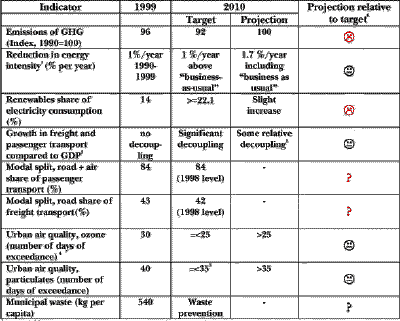
Click the thumbnail above to have an enlarged version of the table [23 Kb]
1 2.4 % per year GDP growth assumed in modeling
2 Depending on the implementation and effect of the measures contained in the 2001 Commission White Paper. (Relative decoupling = the rate of increase in the transport variable is less than the rate of increase in GDP).
3 3 % per year GDP growth assumed in modeling
4 The indicators for 1999 and 2010 are based on different targets due to the introduction of new targets in the ozone directive recently adopted.
5 2005 target
6 The "smiley faces refer to the distance to target based on current policies and measures.
J denotes that achievement of target is probable
K denotes that it is too early to tell whether target will be met
L denotes that achievement of target is improbable, based on current policies and measures
? denotes that assessment is not possible due to lack of information.
Overall Assessment
The assessments of the indicators above, which are taken from the EEA's draft report Environmental signals 2002 and discussed individually in the following sections, show that changes in the European economy that might have been expected to work in the environment's favour, such as the transition to a service economy, have played only a minor role in reducing environmental pressures.
The main reductions in air pollutants and carbon dioxide emissions have been due to fossil fuel shifts in the UK and Germany, economic restructuring in the new German Länder and the widespread introduction of catalysts to reduce air pollutant emissions from new passenger cars. Continued reductions in carbon dioxide emissions on this scale are not expected in the coming years given current policies and measures. More is needed from improvements in energy efficiency. Excluding Germany's contribution, the EU's energy efficiency improved by only 0.3% annually between 1990 and 1999, far less than economic growth. The assessment identifies the transport sector as a major contributor to the environmental pressures, while at the same time the sector's progress in improving energy efficiency has been limited. This is also true for the households sector.
The energy efficiency of the passenger transport sector has improved only slightly, as a result of advances in technology. Freight transport shows no improvement in energy efficiency. The discrepancy between improvements in technology and actual energy efficiency gains is the result of changes in transport conditions (e.g. heavier and more powerful vehicles, low occupancy rates and load factors) and unfavourable development of the modal split. Transport volumes are growing drastically, closely linked to economic growth. Transport pricing, infrastructure development and physical planning play a major role in this. As a consequence of these developments, carbon dioxide emissions from the transport sector are continuing to grow. On the other hand, it should be noted that environmental regulations aimed at decreasing air-polluting emissions from transport, through fuel quality and vehicle emission standards, have been more successful. They have resulted in an absolute decoupling of the emissions of acidifying substances and ozone precursor substances from transport development.
Policies and actions aimed at increasing the use of renewable energy have also been successful in some Member States; they contributed to growth in renewable electricity generation of 2.8% per year. However, since electricity consumption grew by almost the same rate, the share of renewable energy in electricity generation remained almost constant during the 1990s. To reach the indicative EU target substantial growth in renewable electricity, and/or a lower rate of overall electricity consumption growth, will be required. The additional measures contained in the EU renewable electricity Directive, together with measures taken at Member State level, need to give a stronger stimulus to the deployment of renewable energy technologies.
There are some indications that total waste generation is developing more slowly than growth of GDP as a result of lower generation of mining waste. Industrial waste generation also seems to be stabilising. For municipal waste generation (around 14% of total waste), all EU Member States have reached a similar level of waste production, with some minor differences explained by lifestyle and consumption patterns.
Future development of the environmental sustainability indicators for the Synthesis Report
The development of the 2002 Synthesis Report for the Barcelona Council had to be conducted in rather a short time frame. It is generally acknowledged that more discussion is needed on the indicators to be included in future editions. The December 2001 Council decision on the adoption of the list of seven environmental indicators for the Barcelona Synthesis Report thus also included a list of 34 environmental sustainability indicators to be further scrutinised and developed. It is now up to the Commission, Eurostat and the EEA in co-operation with the Member States to do this. In practice an analytical report will be produced by the three organisations and discussed with the member countries. The document will probably lead to a choice of new indicators for the 2003 Synthesis Report in the priority areas indicated by the Environment Council: public health (in particular chemicals); and sustainable resource management (in particular water, biodiversity and resource use).
In the analysis of the 34 possible future indicators a number of elements will have to be taken into account. Important for the Environment Council is the inclusion of pure environmental indicators that allow progress to be followed in the environment part of the SDS. These pure environment indicators, such as the amount of municipal waste landfilled and urban air quality, are, however, not immediately appealing to those involved in the socio-economic policy making under the Lisbon process. Linking these indicators with economic variables to establish eco-efficiency ("de-coupling") indicators might be a way to use indicators to arrive at a more integrated assessment in the Synthesis Report.
A similar process might also be necessary for the socio-economic indicators: for example, to make the indicator on electricity prices relevant to assessing sustainable development in the Synthesis Report (which deals with a thriving and competitive economy able to reach Kyoto targets at the lowest costs), a link needs to be made with the consumption of electricity and finally with greenhouse gas emissions. This underlines the need for developing an integrated assessment of all aspects of sustainable development to support policy.
Making the indicators more useful for policy makers also calls for reflection on the best format for presenting the structural indicators. Recognising the huge advantages of a standardised presentation of all indicators, messages can often be communicated better with dedicated presentations for indicators (or groups of indicators). This strengthens the case for the provision by Eurostat and the EEA of a self-standing compilation of the environmental sustainability indicators in the Synthesis Report together with their assessments. The timing and linking of these processes have to be designed carefully for effective and efficient use of the most up to date information.
Emissions of greenhouse gases
Targets and policy relevance
The Kyoto protocol commits the EU to an 8 % decrease in total emissions of six greenhouse gases from 1990 to 2008-12. Individual aggregated targets for each Member State are laid down in the EU burden-sharing agreement (European Commission, 2001a).
Reductions in emissions of greenhouse gases are necessary to combat climate change, one of the priorities of the Sustainable Development Strategy. All sectors of society contribute to some extent to emissions of greenhouse gases, demonstrating the need for a broad integration of economic, social and environmental policies within the strategy and within the European Climate Change Programme (European Commission, 2001b). The transport and energy sectors, covered by other structural indicators, are the most important contributors to greenhouse gas emissions.
Structural indicators
Aggregated emissions of six greenhouse gases (carbon dioxide, methane, nitrous oxide, hydrofluorocarbons, perfluorocarbons and sulphur hexafluoride) expressed as carbon dioxide equivalents.
Observed trends
- Total emissions decreased by 4 % between 1990 and 1999, in line with the linear path from 1990 to 2008-12 needed to reach the overall EU reduction target under the Kyoto Protocol.
- Reductions in emissions in Germany and UK provided much of the reduction in total EU emissions.
- Emissions in most other Member States are significantly above the linear paths needed for them to achieve their agreed individual burden-sharing targets.
- During the same period, US greenhouse gas emissions increased by 11.4 % (US EPA, 2002) compared with its Kyoto-assigned target of a 7 % reduction by 2008-2012.
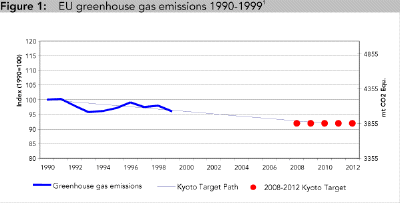
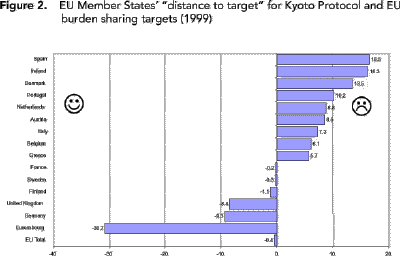
Click the thumbnails above to have a large versions of the figures.
Source: EEA compilation of Member States data submitted to UNFCCC and EU Monitoring Mechanism (EEA, 2001).
Note: Target: The EU Kyoto Protocol and for each EU Member State the target as agreed within the EU burden sharing agreement. All six Kyoto gases are included. The distance-to-target indicator is a measure of how close the current emissions (1999) are to a linear path of emissions reductions from 1990 to the Kyoto target for 2008-2012 (for total greenhouse gas emissions).
1 This statement is based on the assumption, for the purpose of this report, that the EU will meet its Kyoto Protocol target by using only domestic policies and measures. At the latest conference under the UN Framework Convention on Climate Change (Marrakesh, November 2001) countries agreed on the rules for the use of both the flexible mechanisms (joint implementation, clean development mechanism, international emissions trading) and sinks for meeting the Kyoto targets (UNFCCC, 2002). After ratification (expected in 2002), the European Community and the EU Member States could therefore also use these options to meet their targets, although it is not known yet to what extent this will be the case.
Projections
- Based on both Community-wide and Member States' projections, EU greenhouse gas emissions are projected to be around 1990 levels by 2010 on the basis of existing policies and measures. Projections of emissions from transport see a rise of more than 30% by 2010.
- All Member States, except UK, project their emissions by 2010 to be above their burden-sharing target.
Trends by pollutant and sector
- Reductions in emissions of nitrous oxide and methane account for most of the overall reduction. Emissions of carbon dioxide, the main greenhouse gas, have been reduced by 2% between 1990 and 1999.
- Decreases in emissions from the energy sector have been offset by increases from road transport.
Figure 3. Change (%) in EU greenhouse gas emissions by sector and pollutant (1990-1999)
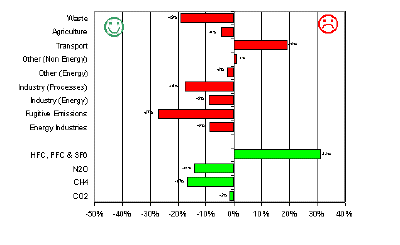
Click the thumbnail above to have a large version of the figure.
Assessment
The emissions drop of 4% between 1990 and 1999 was due to a combination of favourable factors. However, some of these will not be repeated, such as:
- One-off introduction of technical measures to reduce N2O emissions at adipic and nitric acid production plants in France and the UK and reduce HFC emissions from the UK HFC industry;
- The shift from coal to gas seen during the 1990s, particularly in Germany and the UK;
- Relatively mild winters (in 1999) in Germany, UK, France and the Netherlands, which reduced energy use for indoor heating.
Preliminary estimates (DIW, 2001) indicate that total EU CO2 emissions increased 0.9% from 1999 to 2000, implying a decrease of 0.6% from 1990 to 2000. According to these estimates and the UK national inventory, CO2 emissions increased by almost 2% in the UK and stabilised in Germany between 1999 and 2000.
EU greenhouse gas emissions are projected to be at around 1990 levels in 2010 on the basis of existing policies and measures, including the agreement with the car industry to reduce carbon dioxide emissions from new passenger cars. All Member States, except UK, project their emissions by 2010 to be in excess of their burden-sharing target.
Projections of GHG emissions from the transport sector indicate a rise of more than 30 % by 2010. (In accordance with UNFCCC rules/guidelines, this excludes emissions from international transport. These emissions were estimated to be 6 % of total EU GHG emissions in 1999).
Therefore, achieving the Kyoto Protocol targets for the EU and the Member States is expected to require substantial additional efforts.
Member States have identified additional policies and measures that could help reduce the gap by about 210 Mt CO2 eq,, or 5% of 1990 emissions. The missing 3%, or about 110 Mt CO2 eq., will need to be found through further additional measures both at Member State and EU level. The additional savings of about 190 Mt CO2 eq. that have been identified by Germany and the UK should be regarded as an over-delivery' of reductions that cannot be taken for granted by the rest of the Community as a way of helping to meet the Kyoto target.
Measures in an advanced stage of preparation from the European Climate Change Programme) are estimated to provide a cost-effective reduction potential of 240 Mt CO2 eq (European Commission, 2001c).However the realisation of this technical potential depends on a number of factors including the accuracy of data, political acceptability and the timeframe within which they are implemented.
References
DIW (2001). DIW-Wochenbericht 45/01, CO2-Emissionen: Trendwende noch nicht in Sicht, Deutsche Institut für Wirtschaftsforschung (German Institute for Economic Research), November 2001.
EEA (2001). European Community and Member States greenhouse gas emission trends 1990-1999, EEA Topic report 10/2001, Copenhagen.
European Commission (2001a), Proposal for a Council Decision concerning the approval, on behalf of the European Community, of the Kyoto Protocol to the United Nations Framework Convention on Climate Change and the joint fulfilment of commitments there under, COM (2001) 579 final, Brussels.
European Commission (2001b), Communication on the implementation of the first phase of the European Climate Change Programme, COM (2001) 580 final, Brussels.
European Commission (2001 c). Economic Evaluation of Sectoral Emission Reduction Objectives for Climate Change: Summary Report for Policy Makers, March 2001, Brussels.
UNFCCC (2002), Report of the Conference of the Parties on its Seventh Session, held at Marrakesh from 29 October to 10 November 2001, Part 2 "Action taken by the Conference of the Parties at its Seventh Session, "The Marrakesh Accords", FCCC/CP/2001/13, Addendum 1,2 and 3, 21 January 2002.
US EPA (2002), Draft Inventory of U.S. Greenhouse Gas Emissions and Sinks: 1990 -- 2000, U.S. Environmental Protection Agency, Washington, U.S.A. , February 2002.
Energy intensity of the economy
Targets and policy relevance
Depending on the source, energy production and consumption can lead to emissions of greenhouse gases and air polluting substances as well as to other environmental pressures. Reducing energy intensity can therefore help to combat climate change and protect human health and natural resources, priorities of the Sustainable Development Strategy.
The European Commission has proposed and the Council (Council, 1998) supported an EU indicative target of reducing final energy intensity (consumption by final energy consumers per unit of GDP) in the period 1998 to 2010 by 1 percentage point per year above that which would have otherwise been attained.'
The energy intensity indicator examined here covers all energy consumers, including final energy consumers.
The indicator shows the extent of de-coupling between energy consumption and economic growth, which can play an important role in reducing the impact of energy use on the environment.
Structural indicator
Gross inland energy consumption divided by GDP.
Observed trends
- Energy intensity decreased at an average rate of just over 1 %/year in the period 1990 to 1999.
- Annual rates of change for individual Member States varied from -- 4.5 to +1.4 %.
- The rate of decrease in energy intensity in relation to the growth in GDP reflects an increase in energy use of over 9 % in the period.
2 It is not clear how such a target can be measured and monitored, since that which would have otherwise been attained' is difficult to define.
Figure 4. Index of energy intensity, EU15

Click the thumbnail above to have a large version of the figure.
Notes: Gross Inland Energy Consumption is a measure of the energy inputs to an economy and can be calculated by adding total domestic energy production, energy imports minus energy exports, and net withdrawal from existing stocks. Gross Domestic Product (GDP) is a measure of output of an economy.
Source: Eurostat
Figure 5. Gross Inland Energy Consumption intensity annual rates of change
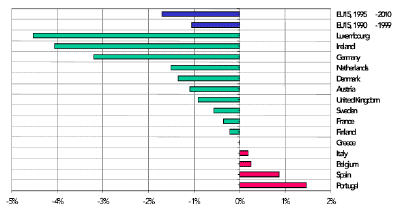
Click the thumbnail above to have a large version of the figure.
Source: Eurostat, ECOFYS, 2001
Projections
Projections (ECOFYS, 2001) suggest an average decrease in energy intensity of 1.7 percentage points per year from 1995 to 2010, primarily due to continued restructuring of the economy (see below), but also due to improvements in energy efficiency and energy conservation.
Assessment
Much of the improvement in the period was due to structural changes in the economy, including a shift away from industry towards services that are typically less energy intensive, and within the industrial sector from energy intensive industries towards high value added, less energy intensive industries.
Given Germany's high levels of energy consumption, its decrease in energy intensity of over 3% annually contributed much to the reduction in energy intensity of the EU as a whole. Excluding Germany, however, EU energy intensity decreased at an annual rate of only 0.3% over the 1990-1999 period.
The EU's GDP is expected to grow at an average rate of about 2.4% per year between 2000 and 2010 (ECOFYS, 2001). The projected reduction in energy intensity is thus lower than expected GDP growth, leading to a further increase in energy consumption. Given the slow rate of change towards using less carbon-intensive fuels, the increase in energy consumption may lead to an increase in greenhouse gas emissions by 2010.
References
Council resolution of 7 December 1998 on energy efficiency in the European Community (OJ 1998.C 394/01)
Energy efficiency in the European Community -- towards a strategy for the rational use of energy COM (1998) 246 final
ECOFYS, 2001. Economic evaluation of sectoral emissions reduction objectives for climate change. A report for European Commission Directorate General Environment from ECOFYS Energy and Environment, AEA Technology and the National Technical University of Athens (NTUA). Energy projections used in the report originate from the Primes model (NTUA).
Electricity from renewable energy sources
Targets and policy relevance
The EU has set an indicative target of achieving 22.1 % of gross electricity consumption from renewable sources by 2010.
Renewables help to reduce greenhouse gas emissions from the production and consumption of energy and are thus important in combating climate change, one of the priorities of the Sustainable Development Strategy.
Structural indicator
Contribution of electricity from renewables to gross electricity consumption (%)
Observed trends
- For the EU as a whole, the share of electricity consumption from renewables grew from 13.4% in 1990 to 14 % in 1999.
- In 1999, the share in individual Member States varied from 1.4 % to 72.3 %.
- In absolute terms, hydro dominated the picture. However, its relative share fell during the period, while solar and wind, and biomass and waste increased theirs. The share of geothermal was fairly constant.
Figure 6. Electricity from renewable energy sources as a percentage of gross electricity consumption, EU 1990-1999
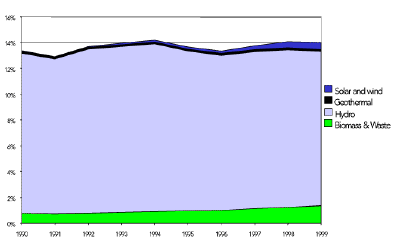
Click the thumbnail above to have a large version of the figure.
Notes: Gross Electricity Consumption includes domestic electricity production and electricity imports, minus electricity exports. "Biomass & Waste includes wood, wood wastes, other biodegradable solid wastes, industrial and municipal waste (of which only part is biodegradable), biofuels and biogas.
Source: Eurostat.
Figure 7. Electricity from renewable energy sources as a percentage of gross electricity consumption, 1999
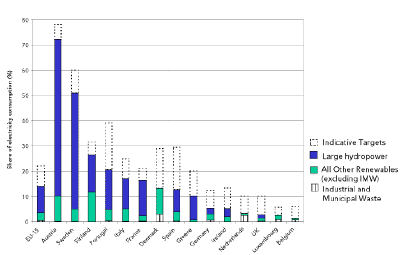
Click the thumbnail above to have a large version of the figure.
Notes: Industrial and Municipal Waste (IMW) includes electricity from both biodegradable and non-biodegradable energy sources, as there are no data available for the biodegradable part alone. The share of electricity from renewable energy sources in gross electricity consumption is therefore overestimated by an amount equivalent to the electricity from non-biodegradable industrial and municipal waste. National indicative targets shown here represent reference values that Member States agreed to take into account when setting their indicative targets by October 2002, according to the renewable electricity Directive.
Source: Eurostat.
Projections
Baseline Projections (ECOFYS, 2001) indicate a negligible increase in the share of renewable energy sources in gross electricity consumption by 2010. The baseline projections were based on policies and measures in place by November 1997. These baseline projections missed the trend of increased production of electricity from renewable energy sources in the second half of the 1990s. It is likely that the new, updated, version of the baseline projections, to be released later in 2002, will show a moderate increase in renewable electricity production but only a slight increase in the expected share of renewable electricity in gross electricity consumption in 2010 due to increasing total electricity consumption.
Assessment
Between 1990 and 1999, electricity from renewable energy sources grew at an average annual rate of 2.8% per year.
Electricity from renewable energy sources is dominated by large hydro-power (74 % in 1999) followed by small hydro (11 %) and biomass/waste (10 %). Electricity production from hydro-power also reflects annual precipitation levels.
Production from large hydropower projects is not expected to increase substantially in future due to concerns about their impact on the environment. Therefore, future growth in renewable electricity will have to come from all other renewable energy sources.
The share of electricity from renewable sources varies considerably between countries, reflecting the resources within their boundaries but also the support measures taken by them to promote renewable energies.
Taking account of projected growth rates for electricity consumption to 2010 (ECOFYS, 2001), the indicative target will require the rate of growth of renewable electricity supply roughly to double if the target is to be met.
For the indicative target to be attained, the additional measures contained in the EU Directive, together with measures taken at Member State level, need to give a stronger stimulus to the deployment of renewable electricity technologies. There are encouraging signs that this may be possible with the right mix of support measures. For example the rapid expansion of wind power (38% per year across the EU between 1990 and 1999) was driven by high growth rates in Germany, Denmark, and Spain. These were the result of support measures including feed-in' arrangements that guarantee a fixed favourable price for renewable electricity producers (EEA, 2001).
References
European Parliament and the Council, 2001. Directive on the promotion of electricity produced from renewable energy sources in the internal electricity market. Directive 2001/77/EC.
ECOFYS, 2001. Economic evaluation of sectoral emissions reduction objectives for climate change. A report for European Commission Directorate General Environment from ECOFYS Energy and Environment, AEA Technology and the National Technical University of Athens (NTUA). Energy projections used in the report originate from the Primes model (NTUA).
EEA, 2001. Renewable energies: success stories. Environmental Issues series no. 27. European Environment Agency, Copenhagen.
Volume of transport relative to GDP
(freight and passengers)
Targets and policy relevance
In its Sustainable Development Strategy, the EU has set itself the objective to bring about a significant decoupling of transport growth and GDP growth' (European Council, 2001). In the White Paper "European Transport Policy for 2010: Time to Decide (European Commission, 2001a), the Commission has proposed measures to reach this objective.
Transport is one of the main sources of greenhouse gases and also gives rise to significant air pollution. This indicator is therefore linked to combating climate change and the protection of human health and natural resources, priorities of the Sustainable Development Strategy.
Structural indicators
1. Volume of passenger transport relative to GDP, passenger-km/GDP
2. Volume of freight transport relative to GDP, tonnes-km/GDP
Observed trends
- During the 1990s, passenger transport grew at about the same rate as the economy. Per unit of GDP it grew in the first half of the decade but then fell back and ended at 2 percent points under the 1991 level in 1999.
- Freight traffic grew substantially faster than the economy, in particular from 1996 onwards. Between 1991 and 1999 freight transport per unit of GDP grew by 14 percentage points.
- Five Member States (Belgium, Greece, Italy, Portugal and Spain) experienced higher growth in passenger transport than in GDP, while the other Member States had a relative fall.
- On the freight side, lack of short-sea shipping data after 1996 hampers inclusion of this mode at the country level. Without short-sea shipping, seven Member States experienced growth higher than that of GDP between 1991 and 1999.
3 The Eurostat statistics used in this fact sheet are those used by the Commission for the Structural Indicators, and do not include waterborne, motorcycle and extra-EU air passenger transport. In contrast, indicators used in the Transport and Environment Reporting Mechanism (TERM), developed by the EEA in cooperation with Eurostat, DG TREN and DG Environment, include intra-European and inter-continental flights as well as waterborne and motorcycle transport.
Figure 8. Passenger and freight transport in relation to GDP 1991-1999 and projections to 2010 (EU15)
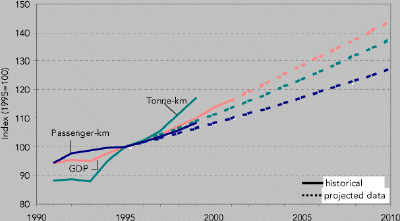
Click the thumbnail above to have a large version of the figure.
Source: Eurostat; Projections: European Commission, 1999 and 2001b
Note: Aviation (passenger transport) includes domestic and intra-EU only. Modes used for freight transport: road, rail and inland navigation (no short-sea shipping). Modes used for passenger transport: passenger cars, bus/coach, rail, and (domestic and intra-EU) air (tram/metro not included in PRIMES, historical motorcycle and inland navigation data not available).
Projections
PRIMES projections (using 1995 as base year) saw passenger transport, and to a lesser extent freight transport, volumes increasing at a slower rate than GDP by 2010 (see figure 8). However, both passenger-km and tonne-km grew faster than projected between 1995 and 1999, which indicates that the PRIMES projections are probably no longer reliable.
Assessment
The Commission White Paper proposes measures to reach the objective of a significant decoupling of transport growth and GDP growth. However, it is unclear to what extent the proposed measures will contribute to realising the objective.
Passenger transport
Passenger transport grew at the same pace as GDP between 1991 and 1999. Road and air transport are by far the fastest-growing modes. The main factors underlying growth in passenger transport are growing incomes and car ownership, low transport prices (due to a lack of internalisation of external costs), infrastructure development, increasing distances to basic services, and low occupancy rates.
Future passenger travel is expected to grow less than income, because of limitation of the average speed of travelling (due to safety concerns and congestion) and the assumption that people have a fixed time budget for travelling. Also, the strong growth in car ownership in current Member States is expected gradually to level out, because of saturation of roads and car ownership. However, this will not be the case in the candidate countries; EU enlargement is expected to result in significant added growth of passenger transport.
Freight transport
Freight transport volume is growing faster than GDP. Driving factors are the globalisation of the economy and the liberalisation of the internal market (reducing constraints on cross-border movements and related barrier costs'). This is leading to longer transport distances and more complex trading networks primarily to exploit differentials in labour cost. Additional factors are low load factors (empty runs account for between 25 and 40 % of total vehicle-km ) and low transport prices (transport is cheap compared to the costs of labour and the products transported).
The main assumption for the projected decoupling of freight transport demand and economic growth is a gradual shift away from industry towards a knowledge-based economy. However, the above-mentioned factors could counterbalance any benefits from this shift, as appears to have been happening in most recent years (see Figure 8). Again, enlargement of the EU is expected to increase transport flows, and in particular road haulage traffic.
References
European Commission, 1999: The Shared Analysis Project - Economic Foundations for Energy Policy. Special issue, Directorate General for Energy. Brussels, Belgium, December 1999.
European Council, 2001: Göteborg European Council - Presidency Conclusions (15-06-2001). http://ue.europa.eu/Newsroom/LoadDoc.asp?BID=76&DID;=66787⟨=2
European Commission, 2001a: European transport policy for 2010: time to decide. COM (2001) 370. White paper of the Commission of the European Communities. Brussels, Belgium, 12 September 2001. http://europa.europa.eu/comm/energy_transport/library/lb_texte_complet_en.pdf
European Commission, 2001b: Economic Evaluation of Sectoral Emission Reduction Objectives for Climate Change - Economic Evaluation of Emissions Reductions in the Transport Sector of the EU. Contribution from AEA Technology Environment (Judith Bates, Christian Brand, Paul Davison, Nikolas Hill) to a Study for DG Environment, European Commission, by Ecofys Energy and Environment, AEA Technology Environment and National Technical University of Athens. Final Report, Update March 2001.
http://europa.europa.eu/comm/environment/enveco/climate_change/transport_update.pdf
Eurostat: Transport and environment: statistics for the transport and environment reporting mechanism (TERM) for the European Union. Luxembourg. Statistical compendium containing all data to be published.
4 based on data from Germany, The Netherlands and the UK
Modal split of transport(freight and passengers)
Targets and policy relevance
As part of the Sustainable Development Strategy, the EU has set itself the goal of bringing about a shift in transport use from road to rail, water and public passenger transport. In its White Paper "European Transport Policy for 2010: Time to Decide (European Commission, 2001), the Commission has proposed various measures with the aim of stabilising modal shares at 1998 levels by 2010.
The modal split of transport has relevance for emissions of greenhouse gases and air polluting substances, and therefore has consequences for climate change and the protection of human health and natural resources, priorities of the Sustainable Development Strategy.
Structural indicators
1. Modal split in passenger transport between road/air and others, passenger-km.
2. Modal split in freight transport between road and others, tonnes-km.
Observed trends
- The more environmentally friendly modes of passenger transport (rail, tram/metro, bus/coach) lost 2 % of their share between 1991 and 1999.
- Transport by car was stable at just over 80 % of total passenger transport from 1991 to 1999.
- Intra-EU aviation increased its market share from 2 to 3 % over the same period.
- At Member State level, the proportion of car passenger transport varied from 72 % to 85 % in 1999.
- On the freight side, excluding short sea shipping, the range was much greater: the share of road transport varied from 40 % to 98 % in 1999.
5 The Eurostat statistics used in this fact sheet do not include waterborne, motorcycle and extra-EU air passenger transport.
6 In the indicators used in the Transport and Environment Reporting Mechanism (TERM) developed by the EEA in cooperation with Eurostat, DG TREN and DG Environment, intra-European air traffic and inter-continental flights are included, bringing the share of aviation in total passenger transport to 10% in 1999.
Figure 9. Road and air (passenger) and road (freight) shares of total transport, 1991-1999
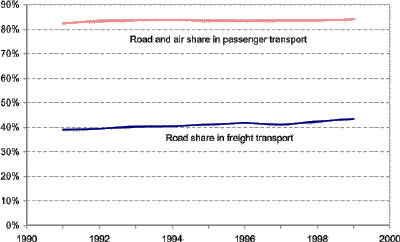
Click the thumbnail above to have a large version of the figure.
Source: Eurostat
Note: Passenger transport includes passenger car, rail, tram/metro, bus/coach and intra-EU aviation; freight transport includes road, rail, inland navigation and short-sea shipping
Figure 10. Car's share of passenger transport, by country (1999).
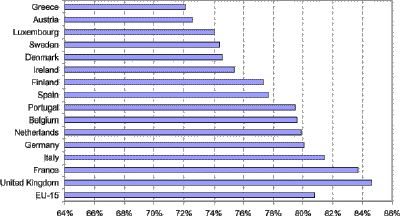
Click the thumbnail above to have a large version of the figure.
Source: Eurostat
Note: Only road, rail, tram/metro and air are included (inland waterways and motorcycles left out due to missing data).
Figure 11. Terrestrial freight transport (ie excluding short sea shipping): share of road transport, 1999
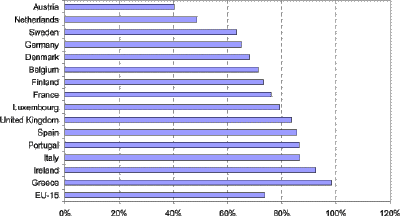
Click the thumbnail above to have a large version of the figure.
Note: Only road, rail, inland waterways and oil pipelines are included (short-sea shipping left ou due to missing country breakdown).
Source: Eurostat
Projections
Assuming a business-as-usual trend, the 2001 Commission White Paper estimates that the total road and air share of passenger transport in 2010 would be 86 %, i.e. slightly higher than the 1998 baseline year. These indicative projections are almost consistent with those of PRIMES (European Commission, 1999), which projects this share to be 85 % in 2010.
The White Paper expects that if current trends continued, road's share of total freight in 2010 would be 47 %, again higher than in the reference year 1998. These projections cannot be verified, however, since PRIMES does not include short-sea shipping.
Assessment
The Commission White Paper proposes various measures with the aim of stabilising modal shares. It is, however, unclear how far the proposed measures will contribute to achieving this modal stabilisation, or what the extent of the environmental gains will be if stabilisation is reached.
Passenger car use has been boosted by growing car ownership (closely correlated to GDP growth) and road infrastructure development. In terms of quality (of infrastructure and services) public transport and rail often lag behind road transport. Moreover, the price of car transport (and aviation) versus that of other modes is relatively low. Leisure trips, commuting and shopping account for the vast majority of trips. Long distance passenger travel, and in particular aviation, is growing as rising incomes boost tourism.
The trend in modal shares for freight and the preference for road can be explained by the fact that modern trade demands just-in-time' delivery of goods. Transport speed and flexibility are therefore of great importance. Despite congestion, road transport is often still faster and more flexible than rail or water transport.
The road sector is also liberalised to a great extent (with relatively low prices), while the rail sector is just starting to open up. For longer distances, short sea shipping has become quite successful in some parts of the EU. However, growing concerns are being expressed concerning the environmental performance of shipping (in particular related to its high emissions of acidifying substances).
References
European Commission, 1999: The Shared Analysis Project - Economic Foundations for Energy Policy. Special issue, Directorate General for Energy. Brussels, Belgium, December 1999.
European Council, 2001: Göteborg European Council - Presidency Conclusions (15-06-2001). http://ue.europa.eu/Newsroom/LoadDoc.asp?BID=76&DID;=66787⟨=2
European Commission, 2001a: European transport policy for 2010: time to decide. COM (2001) 370. White paper of the Commission of the European Communities. Brussels, Belgium, 12 September 2001. http://europa.europa.eu/comm/energy_transport/library/lb_texte_complet_en.pdf
http://europa.europa.eu/comm/environment/enveco/climate_change/transport_update.pdf
Eurostat: Transport and environment: statistics for the transport and environment reporting mechanism (TERM) for the European Union. Luxembourg. Statistical compendium containing all data to be published.
Urban air quality
Targets and policy relevance
The present analysis relates to selected mandatory and indicative short-term objectives for ozone and fine particulates, hereafter referred to as "the objective(s).
For ozone, the current objective is the threshold value to protect human health set in the existing ozone directive of 110 mg/m3 as an 8-hour average. The recently agreed ozone directive (repealing the earlier one) sets a long-term objective of 120 mg/m3 as a maximum daily 8-hour average. As of 2010, the target is that this concentration should not be exceeded on more than 25 days per calendar year, averaged over three years.
For fine particulates (PM10), the objective referred to here is the 24-hour limit value for the protection of human health of 50 mg/m3 not to be exceeded on more than 35 days a calendar year as of 2005.
Ozone and fine particulates in urban air are associated with significant negative effects on human health, including excess mortality, and are considered as priority pollutants in the Commission's Clean Air For Europe (CAFE) programme.
Structural indicators
1. Average number of days with exceedances of the present ozone objective (110 mg/m3 8-h mean)
2. Average number of days with exceedances of the 2005 particulates objective.
For ozone, adequate urban monitoring data is available from 1995 onwards for areas where more than half of the total EU15 urban population live. For fine particulates, adequate data exists only from 1997 onwards.
In the structural indicator, results are displayed for only two years, 1998 and 1999. In this paper, 1997 data are displayed as well.
Observed trends
- Ozone concentrations exceeded the objective on 20--30 days a year on average. Most exceedances are in central and southern European countries; for Italy and Greece numbers are particularly high. There is no clear trend across the EU in the period for which adequate data is available. Closer analysis of monitoring data, however, suggests that 1-h and 8-h peak concentrations are decreasing while long-time average values are tending to increase.
- Particulate concentrations exceeded the objective. The number of exceedance days of the particulate objective's reference concentration varied widely both between the reporting Member States and from year to year, precluding any conclusions on trends.
7The average number of exceedance days for a country involves averaging over stations and over cities. Average exceedance days are calculated as the number of exceedances (maximum one per day) divided by the number of monitoring stations. These numbers are then averaged over all cities, weighted by city population. Note that if the average number of exceedance days is below the maximum allowed number, exceedances may still occur at individual stations. The directive objectives are to be met everywhere.
Figure 12. Average exceedances of objectives, ozone 1995-1999 and PM10 1997-1999 (EU 15).
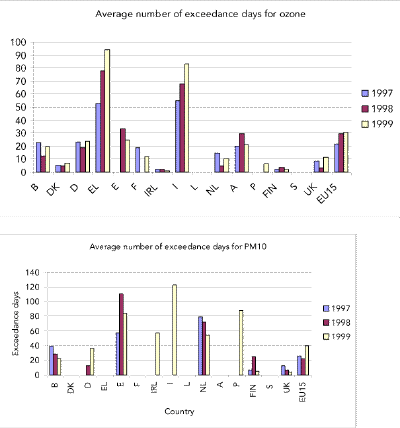
Evidently, the average number of exceedance days may vary by tens of percents from year to year for individual countries. The main reason is that exceedances are associated with certain meteorological conditions, which occur rather randomly in time and space. Differences in monitoring network setup in different countries further affect comparability.
Since the issue at stake is human health, in the view of the EEA, the above information can usefully be supplemented with information on population exposure to the pollutants in question. To estimate the proportion of the total EU urban population (290 million people) experiencing exceedances, the urban population covered by monitoring stations registering exceedances was divided by the urban population covered by all monitoring stations(EEA, 2001).
Figure 13: Population exposure
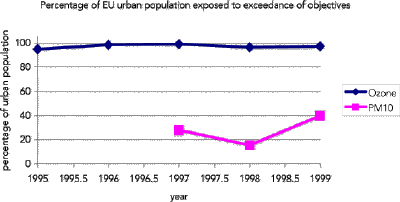
For ozone, almost all the population in EU urban areas covered by monitoring experienced exceedances of the objective; about 14-33% (corresponding to about 41--96 million people) are estimated to live in areas which experienced exceedances on more than 30 days a year. This is a first order-of magnitude indication of the percentage of the population living in areas with exceedance of the target of the recently agreed ozone directive. Data analysis to be published (EEA 2002) indicates that the target value was exceeded in 1999 in about 30 % of the cities with monitoring stations.
For fine particulates, adequate data exist only from 1997 onwards; available data indicate that 20-40 % of the urban population is living in areas where the objective's reference concentration is exceeded on more than 35 days.
It should be noted that actual exposure is considerably lower, since most people are indoors most of the time.
Projections
Emission reductions due to the progressive implementation of existing directives (NEC, VOC, Auto-Oil etc.) are expected to produce significant improvements in urban air quality in the coming years. Projections of urban air quality carried out as part of the Auto-Oil II project (EEA, 2001) suggest that the fraction of the urban population in southern European cities potentially exposed to concentrations which exceed the target value in the new ozone directive (more than 25 days of exceedance of the 8-h average of 120 mg/m3) will decrease from about 70% in 1995 to about 25% in 2010. Further measures will therefore be necessary to ensure that the objectives are met everywhere in the EU.
Assessment
The reduction in short-term peak concentrations of ozone is likely to reflect the emission reductions in Europe of nitrogen oxides (NOx) (25 % reduction since 1990) and non-methane Volatile Organic Compounds (NMVOC) (28% reduction since 1990), from which ozone is formed in the atmosphere. NOx and NMVOC are mainly emitted into the atmosphere from the transport, energy and industry sectors. It is well known that current emission reductions are not sufficient to attain ozone concentrations below the long-term objective in the newly adopted ozone directive. Increasing average ozone concentrations may result from increasing tropospheric background concentrations in the northern hemisphere. In urban areas, ozone concentrations tend to increase in response to moderate reductions of NOx emissions; only upon further reductions of precursor emissions are urban ozone concentrations expected to decrease.
Exceedance of the objective for fine particulates is now a major concern in Europe. With close coordination between the European Commission and the Convention on Long-range Transboundary Air Pollution, major assessment programmes are underway to improve current estimates of emissions and determine the most effective package of measures and policies to reduce and ultimately remove these exceedances. Preliminary analyses indicate that a major part of particulate matter, notably the ammonium sulphates and nitrates originating from the emission of sulphur, nitrogen oxides and ammonia, is subject to long-range transboundary transport and is expected to be reduced as a result of the National Emission Ceilings Directive and the Gothenburg Protocol. However, direct emissions of particulate matter, for instance from wood burning, are estimated to contribute substantially as well and additional measures at European, national and local level are expected to be necessary to comply with the air quality directives.
References
EEA, 2001. Air quality in larger cities in the European Union. EEA Topic Report 3/2001
EEA, 2002, Air quality in Europe 1999, to be published as EEA Topic Report.
Municipal waste
Targets and policy relevance
The generation of waste represents a loss of materials and energy. In recent years, the generation of waste has largely grown in tandem with growth in GDP.
The European Commission's Communication on an EU strategy for sustainable development includes the headline objective of breaking the links between economic growth, the use of resources and the generation of waste, though municipal waste is not specifically mentioned.
The Commission's proposal for the Sixth Environmental Action Programme (6EAP) sets the objectives of decoupling the generation of waste from economic growth, achieving a significant overall reduction in the volumes of waste generated and reducing the quantities of waste sent to final disposal to an absolute minimum. Regarding this last objective, the proposal sets the specific target of achieving a cut of around 20% from 2000 levels by 2010 and of around 50% by 2050. Again, these objectives and targets relate to the entire waste stream, including, but not specifically, municipal waste.
The Fifth Environmental Action Programme (5EAP), which ran from 1993 to 2000, set the target of stabilising the generation of municipal waste at 300 kg per capita, the average EU level for 1985, by 2000. While there is uncertainty over the precise definition of this target, it is clear that it is far from being achieved since over 500 kg of municipal waste per capita are now being generated per year.
The EU Landfill Directive promotes cutbacks in landfilling of waste by requiring Member States to reduce the quantity of biodegradable material landfilled to 35% of 1995 levels by 2016.
Structural indicators
- Municipal waste collected, in kg per person per year
- Municipal waste landfilled, in kg per person per year
- Municipal waste incinerated, in kg per person per year
Observed trends
- Generation of municipal waste remains on an upward trend and reached an EU-15 average of 540 kg per capita in 1999, far above the 5EAP target level of 300 kg per capita for the year 2000.
- Recent years have seen a marked reduction in the overall quantity of waste being sent for final treatment /disposal (landfill or incineration), linked with an increase in recycling rates. However, landfill has remained the prevailing option in many EU countries.
8 Generation is considered equivalent to collection; it is assumed that all municipal waste generated is collected.
Figure 14. Municipal waste generated in selected EU countries
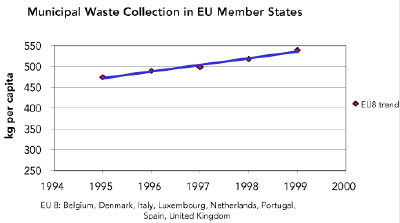
Source: Eurostat
Figure 15. Waste treatment schemes in EU, 1985-99

Source: ETC/WMF
Projections
No projections exist yet for future trends in municipal waste generation. However, it can be said that if the existing trend continues, municipal waste generation will increase.
Assessment
Municipal waste accounts for approximately 14% of total waste. Whereas some reductions in other waste streams have occurred, the generation of municipal waste is still rising.
Generation/collection: Most EU countries have similar levels of municipal waste generation per capita which is not linked to variations in income level. Any differences between Member States may instead be explained by other factors such as consumption patterns and lifestyle.
Landfill/incineration: Tradition and public acceptance are still the decisive factors behind the widespread use of landfilling as an appropriate treatment method, especially in southern Europe. However, meeting the ambitious targets set by the Landfill Directive will inevitably force these countries to strengthen their waste prevention and recycling efforts and/or to consider incineration as an alternative option.
Incineration with energy recovery is mostly accepted in northern European countries. However, in the Mediterranean region public opinion tends to be negative about incineration, seeing it as a costly treatment method which could aggravate existing air pollution problems. This is a significant barrier to its wide-scale use.
References
EEA, ETC/W. Household and Municipal Waste: Comparability of Data in EEA Member Countries, Topic report No 3/2000, April 2000.
Commission of the European Communities: A Sustainable Europe for a Better World: A European Union Strategy for Sustainable Development. COM(2001) 264 final.
Environment 2010: Our future, Our choice - The Sixth Environment Action Programme, COM (2001) 31 final, Brussels, 24.1.2001
(http://europa.europa.eu/comm/environment/newprg/index.htm).
Towards Sustainability: A European Community programme of policy and action in relation to the environment and sustainable development (OJ C 138, 17.5.1993).
Directive 1999/31/EC on the landfill of waste (OJ L182, 16.7.1999).
9 EEA is currently developing a computerised tool for predicting future waste quantities for selected waste streams linked with "what-if-scenarios and emissions of dangerous substances into the environment. When finalised (end 2002- mid 2003), it will be able to provide the needed projections.
![Bullet [round green/blue] Bullet [round green/blue]](https://eea.europa.eu./media/speeches/eea-all-bullet-eea-icon.gif) Working paper March 04, 2002 [Pdf 177 Kb]
Working paper March 04, 2002 [Pdf 177 Kb]
Troubles in downloading?
If you're having troubles in downloading the PDF-file, please go to this page.

















Document Actions
Share with others